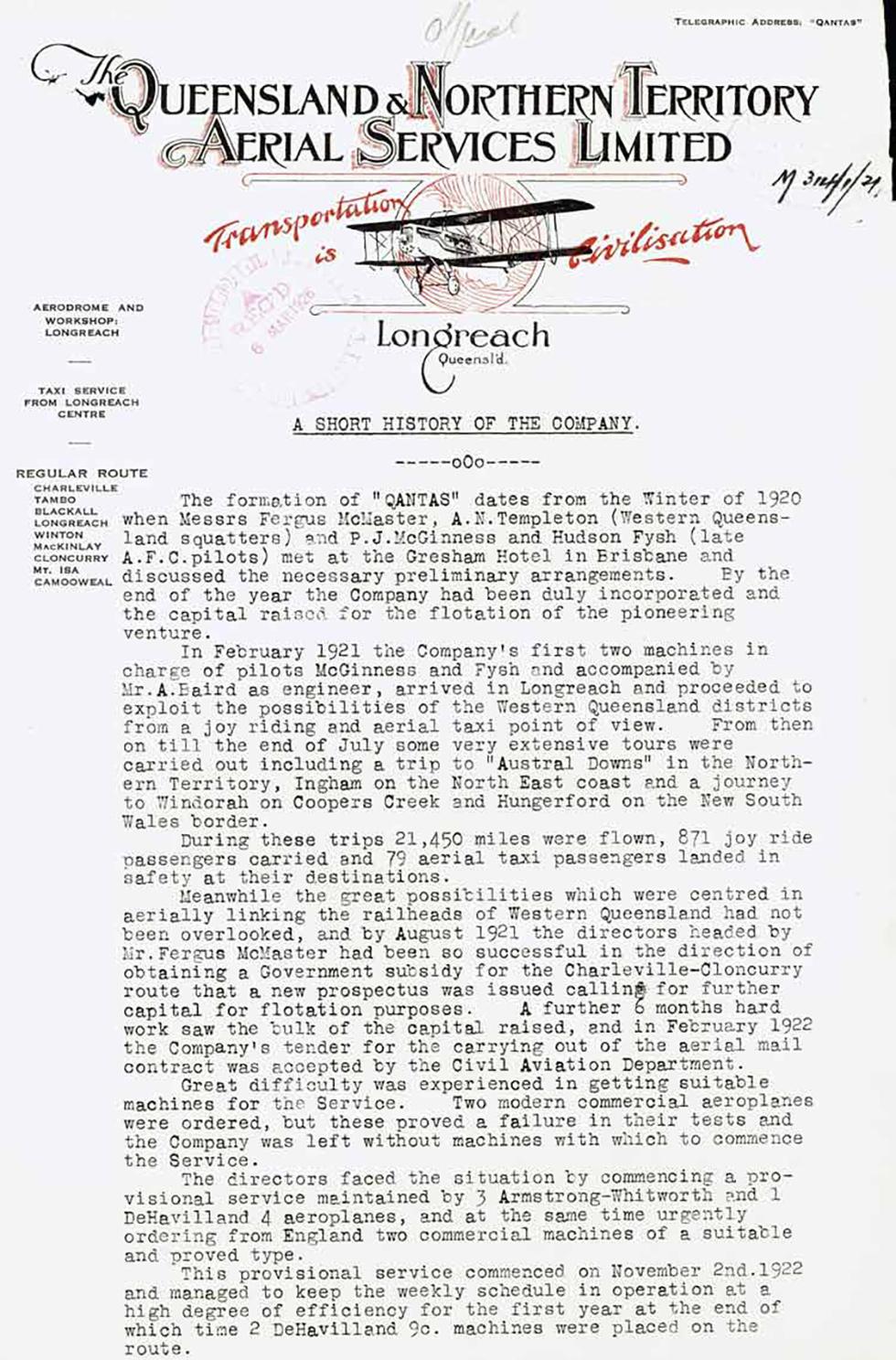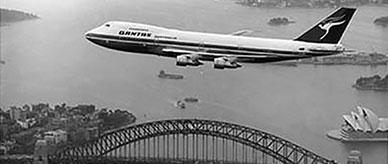


Transcript
[Annotated in pencil at the top of the page:] Official
[Record number added in black ink inside a faded stamp:] M 314/1/4.
[Stamped in red ink 'REC'D [received] 6 MAR 1926'.]
[Printed in the top right corner in small black letters:] TELEGRAPHIC ADDRESS: "QANTAS"
[Letterhead in black and red ink. Heading in large black capitals with red outlines: 'The QUEENSLAND & NORTHERN TERRITORY AERIAL SERVICES LIMITED'. Below this heading, a drawing of an aerophane superimposed over a circle containing red crosshatching indicating a cloud in the sky. Around the drawing, in red italics, is the motto 'Transportation is Civilisation'. Below a dividing line, in black ink, the text 'Longreach', 'Queensl'd'.]
[The following text is printed in the left margin.]
AERODROME AND WORKSHOP: LONGREACH
[dividing line.]
TAXI SERVICE FROM LONGREACH CENTRE
[dividing line.]
[Subheading in larger text:] REGULAR ROUTE
CHARLEVILLE
TAMBO
BLACKALL
LONGREACH
WINTON
MACKINLAY
CLONCURRY
MT. ISA
CAMOOWEAL
[End of text in margin.]
[Underlined heading:] A SHORT HISTORY OF THE COMPANY.
The formation of "QANTAS" dates from the Winter of 1920 when Messrs Fergus McMaster, A.N. Templeton (Western Queensland squatters) and P.J. McGinness and Hudson Fysh (late A.F.C. pilots) met at the Gresham Hotel in Brisbane and discussed the necessary preliminary arrangements. By the end of the year the Company had been duly incorporated and the capital raised for the flotation of the pioneering venture.
In February 1921 the Company's first two machines in charge of pilots McGinness and Fysh and accompanied by Mr. A. Baird as engineer, arrived in Longreach and proceeded to exploit the possibilities of the Western Queensland districts from a joy riding and aerial taxi point of view. From then on till [sic] the end of July some very extensive tours were carried out including a trip to "Austral Downs" in the Northern Territory, Ingham on the North East coast and a journey to Windorah on Coopers Creek and Hungerford on the New South Wales border.
During these trips 21, 450 miles were flown, 871 joy ride passengers carried and 79 aerial taxi passengers landed in safety at their destinations.
Meanwhile the great possibilities which were centred in aerially linking the railheads of Western Queensland had not been overlooked, and by August 1921 the directors headed by Mr. Fergus McMaster had been so successful in the direction of obtaining a Government subsidy for the Charleville-Cloncurry route that a new prospectus was issued calling for further capital for floatation purposes. A further 6 months hard work saw the bulk of the capital raised, and in February 1922 the Company's tender for the carrying out of the aerial mail contract was accepted by the Civil Aviation Department.
Great difficulty was experienced in getting suitable machines for the Service. Two modern commercial aeroplanes were ordered, but these proved a failure in their tests and the Company was left without machines with which to commence the Service.
The directors faced the situation by commencing a provisional service maintained by 3 Armstrong-Whitworth and 1 DeHavilland 4 aeroplanes, and at the same time urgently ordering from England two commercial machines of a suitable and proved type.
This provisional service commenced on November 2nd, 1922 and managed to keep the weekly schedule in operation at a high degree of efficiency for the first year at the end which time 2 DeHavilland 9c. machines were placed on the route.
Need help with your research?
Learn how to interpret primary sources, use our collection and more.

